In theory, calorie counting should be an ideal method of gaining, losing, or maintaining weight. The science is certainly straightforward: the chemical energy used to fuel everything your body does – from walking to running to sleeping to thinking to replenishing damaged skin cells – can be quantified in terms of calories. When you eat more calories than you burn, your body will store the excess energy as fat or lean mass (protein), resulting in weight gain. Conversely, if you burn more calories than you eat, your body will need to break down some of your stored fat and protein to cover the difference, resulting in weight loss. That certainly seems simple enough, yet a lot of people find that they struggle to successfully gain, lose, or maintain weight via calorie counting, even if they consistently hit their calorie targets. So, what could explain this disconnect?
As it turns out, beneath the initial appearance of simplicity, there are several major pitfalls with many of the most popular approaches to calorie counting. In this article, I’ll dig into the reasons why calorie counting may not always work as well as advertised, and explain why MacroFactor can help you avoid the most common pitfalls associated with calorie counting.
Before getting into the meat of this article, let’s briefly define some terms to ensure we’re all on the same page:
Basal Metabolic Rate (or Resting Metabolic Rate; BMR or RMR): this is the amount of energy your body burns at rest. It’s generally measured by monitoring oxygen and CO2 exchange in a lab for 30-60 minutes, and it’s expressed as the amount of calories you’d burn in a day if you didn’t do anything beyond lay in bed. This is the amount of energy required to keep your organs running, to accomplish basic biological processes like cell turnover and repairing damaged proteins, etc. There are subtle differences between basal and resting metabolic rate, but for this particular purpose, we can treat them interchangeably.
Total Daily Energy Expenditure (TDEE): this is the total amount of energy you burn in a day. Your BMR is a significant part of your TDEE, along with the energy required to digest food, energy burned through exercise, and energy burned accomplishing day-to-day activities that aren’t typically categorized as exercise (everything from housework to fidgeting to merely sitting upright instead of laying down).
Non-Exercise Activity Thermogenesis (NEAT): this is the energy burned accomplishing day-to-day activities that aren’t typically categorized as exercise. It’s one component of total daily energy expenditure; the other components of TDEE are discussed in more detail here.
Energy deficit/calorie deficit: a state where you’re burning more calories than you’re consuming. Synonymous with being in “negative energy balance.”
Energy surplus/calorie surplus: a state where you’re eating more calories than you’re burning. Synonymous with being in “positive energy balance.”
Finally, let’s briefly discuss what calorie counting (or any approach to weight gain, loss, or maintenance) should accomplish:
First, it should actually do what it’s supposed to do – help you gain, lose, or maintain weight. Furthermore, if you’re aiming to gain or lose weight, it should help you gain or lose weight at the rate you want.
Second, it should be physiologically sustainable so that you can actually stick with it long enough to accomplish your goals, without any major physical consequences (excessive hunger or lethargy, brain fog, etc.).
Third, it should be able to mesh with your lifestyle, which is critical for long-term success. Most people can white-knuckle their way through an unsustainable weight gain or weight loss attempt for a couple of months, only to revert to their previous weight once they go back to their normal eating patterns. In order to successfully manage your weight long-term, you need to find dietary strategies you can actually stick with long-term.
With all of that out of the way, let’s dive in. We’ll discuss the pitfalls of several popular approaches to calorie counting, and we’ll also discuss why calorie counting may be a bit more complicated than it would initially appear.
Popular calorie counting approach #1: Aiming for a fixed, one-size-fits-all calorie target
This approach to calorie counting is probably the most popular. If you’ve had the displeasure of wading through the swamps of diet culture, you’ve probably seen the recommendation that 1200 calories per day is the appropriate calorie target for women to lose weight (and perhaps the somewhat less popular 1500 calorie recommendation for men). This recommendation has appeared in so many diet books and magazine articles, it has an air of legitimacy to it: “If so many people are giving this recommendation, there must be something to it.” However, as we’ll soon discuss, it’s not a great solution for everyone.
In fact, people who haven’t been sucked into the funnel of diet culture are still exposed to one-size-fits-all calorie recommendations. Nutrition labels subtly encourage people to aim for a calorie intake of approximately 2000 calories per day. Nutrition labels note that caloric needs differ between individuals, but when they tell you what percentage of your daily carbohydrate or protein requirements a product contains, those percentages assume that you’re trying to consume 2000 calories per day. This gives you a small nudge toward aiming for a 2000-calorie diet.
The biggest problem with one-size-fits-all calorie targets is that energy needs vary a lot between individuals. Someone who weighs 130 pounds (about 60kg) will have very different energy needs than someone who weighs 200 pounds (about 90kg) or 330 pounds (about 150kg). Furthermore, two individuals who weigh the exact same amount can still have wildly different energy needs.
For example, a 2021 study by Pontzer and colleagues analyzed total daily energy expenditure in about 6400 individuals around the globe. As you can see, heavier people tend to burn more calories each day, but considerable variability was observed even for individuals at approximately the same weight. For example, the average daily energy expenditure for someone who weighs about 70kg (about 155 pounds) is about 10MJ (about 2400 calories) per day, but some 70kg people barely burn more than 5MJ (about 1200 calories) per day, and some burn in excess of 15MJ (about 3600 calories) per day.
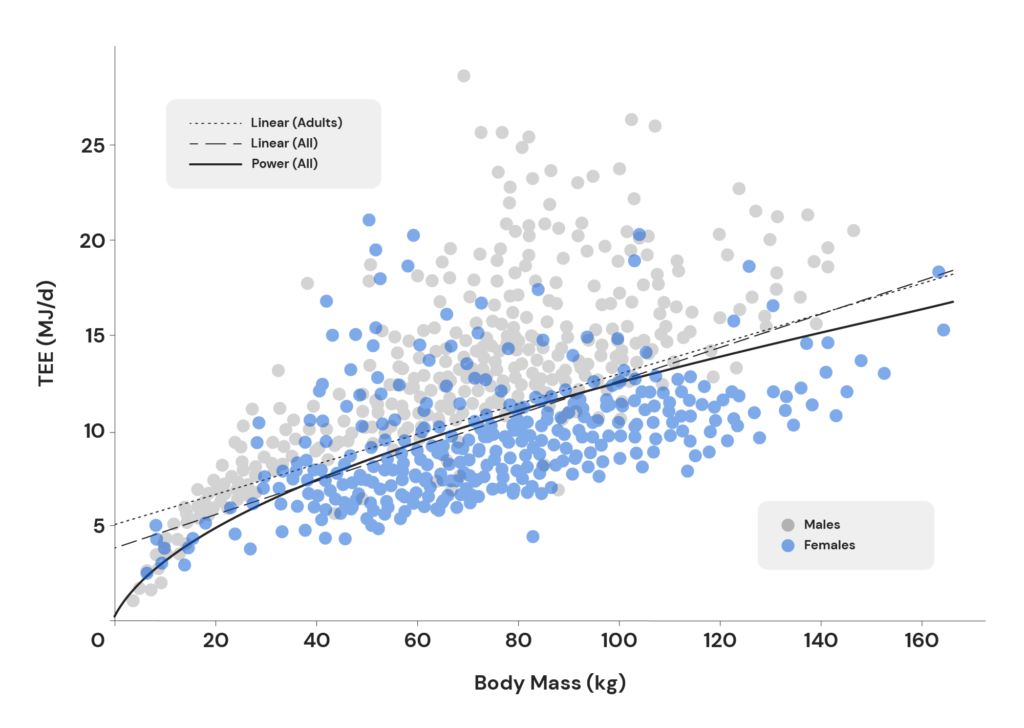
So, the first major problem with one-size-fits-all calorie targets is that they may not actually help you progress toward your goals. A calorie target that may help most people lose weight may be too high to help you lose weight; conversely, a calorie target that may help most people gain weight may be too low to help you gain weight.
The second major problem with one-size-fits-all calorie targets is that they may not be realistic or sustainable. If someone’s aiming to consume 1200 calories per day, and they’re only burning 1500-1600 calories per day, a 1200 calorie per day target may be entirely reasonable and appropriate. However, if they’re burning 2500 calories per day, aiming to consume just 1200 calories is unlikely to be sustainable. Some people may be able to white-knuckle it for a few months, but most people are likely to wind up so tired, lethargic, and hungry that they just can’t stick with such a low calorie target. This can have negative psychological ramifications as well – people end up feeling like they failed as a result of insufficient willpower, thus lowering their self-efficacy for future attempts at weight management. In reality, they were just convinced to attempt a diet that most people would (and do) fail at, because of the simple physiological ramifications of such an extreme calorie deficit.
The third major problem with one-size-fits-all calorie targets is that they don’t set people up for long-term success. If you are one of the people who successfully loses weight with a one-size-fits-all low-calorie diet, the skills you learned to stick with your diet are likely to be incompatible with successful long-term weight maintenance. In effect, you got really good at crash dieting and dealing with caloric deprivation, but not normal, sustainable eating. This can lead to years of yo-yo dieting, rather than long-term success.
Unfortunately, the most popular approach to calorie counting is also the worst, at least in my opinion. While the other approaches on this list come with their own issues, they’re all a step up from merely aiming for a (typically very low) one-size-fits-all calorie target.
Popular calorie counting approach #2: Using activity trackers to determine energy needs
Popular wearable devices claim that they can measure your daily energy expenditure, or at least estimate with reasonable accuracy. With this in mind, many people base their calorie targets for gaining, losing, or maintaining weight on the energy expenditure figure provided by their wearable device. If they’re trying to lose weight, they eat fewer calories than they’re burning (according to their wearable device), and if they’re trying to gain weight, they eat more calories than they’re burning (according to their wearable device).
This is an approach that actually works reasonably well for some people, but it’s far from a sure bet. A 2020 systematic review analyzed the accuracy of popular wearable devices for measuring heart rate, step counts, and energy expenditure. It found that wearables are quite good at measuring heart rate and estimating step counts, but no wearable devices did a particularly good job of estimating energy expenditure. The abstract sums it up nicely: “For energy expenditure, no brand was accurate.”
When you dig further into the data, you can see the sorts of errors wearable devices can produce. While the overall average error is small when pooling results across all studies, average errors in individual studies can be quite large. Average errors smaller than 10% aren’t uncommon, but neither are average errors in excess of 50% (and the error for individual users could be even larger). In other words, if a wearable tells you that you burned 2500 calories, it’s entirely possible that you actually burned 1250 or 3750 calories.
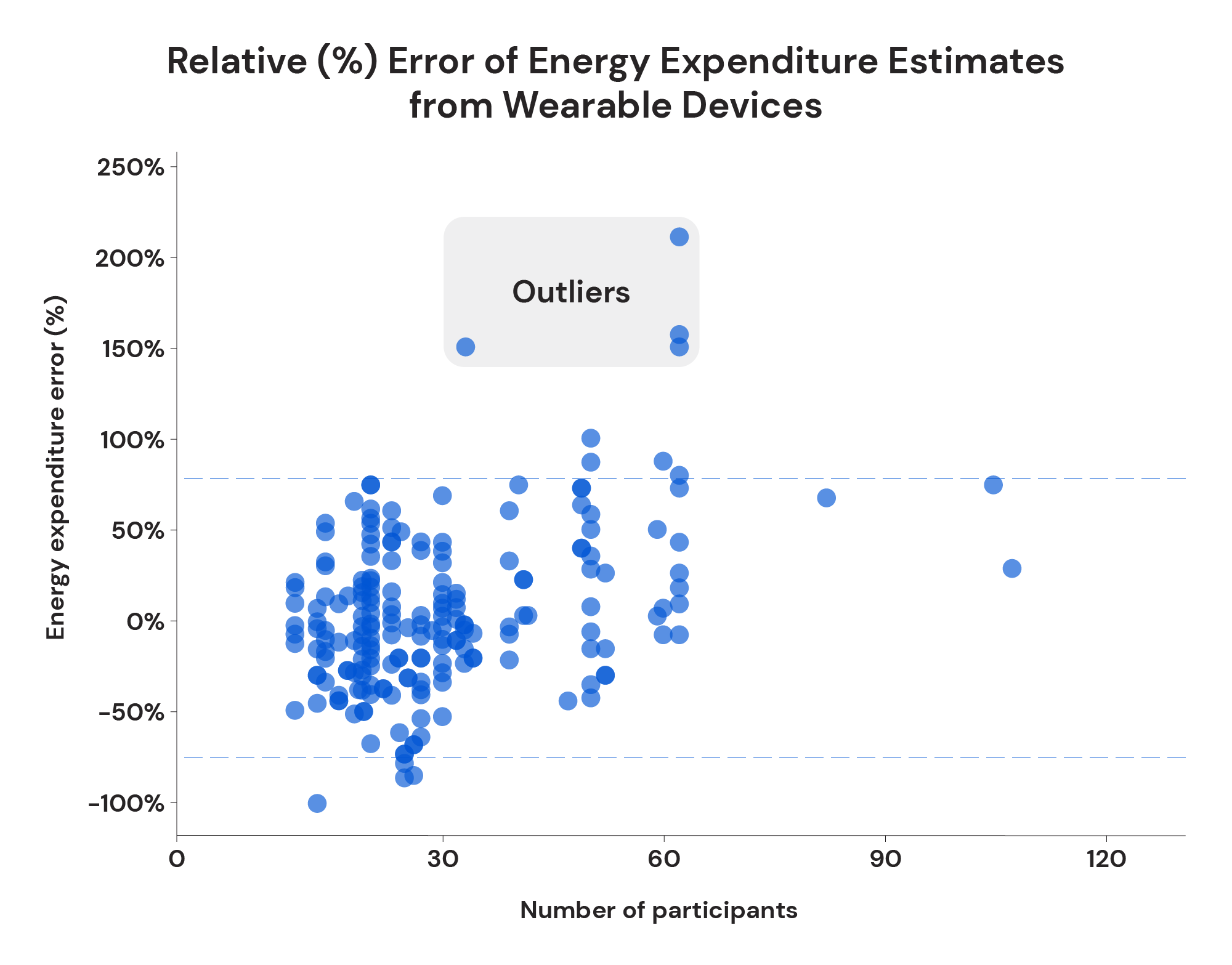
Now, in the interest of fairness, quite a few of the devices analyzed in that 2020 systematic review have been discontinued, so newer devices may be a bit more accurate. However, I’m not optimistic that energy expenditure estimates from wearable devices will ever be particularly precise. The two main technologies that wearable devices use to estimate energy expenditure are heart rate analysis and accelerometry. The relationship between heart rate and energy expenditure inherently differs quite a bit between individuals (due to differences in resting heart rate, different fitness levels, different levels of reactivity to stress, etc.), and accelerometry-based devices (even research-grade devices) also typically produce meaningful errors, which differ in magnitude from study to study, according to a 2020 meta-analysis. It’s worth noting that a combination of heart rate and accelerometry data produces energy expenditure estimates that are more accurate than either technology in isolation; however, since the underlying technologies have far from a 1:1 relationship with energy expenditure, wearable devices are unlikely to have the ability to generate highly precise and accurate individual estimates of energy expenditure any time in the foreseeable future.
For example, a 2022 study found that a newer crop of wearables still did a poor job of estimating energy expenditure during sitting, walking, running, cycling, and resistance training: “for energy expenditure, all 3 devices displayed poor accuracy for all 5 physical activities (CVs between 14.68-24.85% for Apple Watch 6, 16.54-25.78% for Polar Vantage V and 13.44-29.66% for Fitbit Sense) … As for energy expenditure, all 3 devices showed poor accuracy during all activities.” It’s also worth noting that wearable devices are almost certainly less accurate in practice than they are in a lab setting, due to the potential for user error.
In practice, wearable devices generate energy expenditure estimates that are accurate enough to be useful for some percentage of users, for the purpose of gaining or losing weight. However, for most people, wearables generate errors that are too large for those estimates to be useful. For example, a consistent 20% under-estimate or over-estimate of energy needs might mean that you’re actually burning 2500kcals per day, but your wearable device thinks you’re burning 2000kcals or 3000kcals per day instead. If your wearable device says you’re burning 3000kcals per day, you might eat 2500kcals per day with the intention of losing weight, but find yourself not gaining or losing any weight. Conversely, you may try to maintain weight at 3000kcals per day, and find yourself gaining or losing a pound per week.
Based on the current research, it appears that individual errors in excess of 10% (too large to be particularly useful) are far more common than individual errors smaller than 10% (small enough to be quite useful). In other words, if you currently use your wearable device to inform your calorie targets, and you’re having success with this approach, I certainly wouldn’t recommend tossing it aside – you’re one of the lucky ones. However, if you’ve previously tried using a wearable device to inform your calorie targets for the purpose of gaining or losing weight, and you didn’t have success with that approach, just know that you’re not alone. Your experience is the typical experience.
As a final note before moving on, I don’t want it to sound like I’m completely against the concept of using fitness wearables. They’re great for tracking things like step counts and heart rate. They just don’t do a great job of estimating energy expenditure, and so they’re not particularly useful for generating calories targets for most people who want to gain, lose, or maintain weight.
Popular calorie counting approach #3: Using a calorie calculator
When you move beyond the realm of one-size-fits-all calorie targets, the next most popular approach to calorie counting generally involves using equations or online calculators to generate calorie targets.
With these equations or calculators, you generally enter basic demographic and anthropometric information (age, sex, weight, and potentially body fat percentage), and the equation or calculator uses that information to estimate your basal metabolic rate. Most online calculators also ask you to rate your activity levels (sedentary, lightly active, moderately active, or highly active); this generates an activity multiplier. The calculator then multiplies your estimated basal metabolic rate by the activity multiplier corresponding to your activity level, in order to estimate your total daily energy expenditure. So, if one of these equations or calculators estimates that you’re burning 3000 calories per day, you could aim to consume 2500 calories per day to lose weight, or 3200 calories per day to gain weight.
Overall, this is a pretty solid method of generating initial calorie targets, but it’s still a method with the potential for producing inappropriate calorie targets for a lot of folks, and it comes with pitfalls when you’re attempting to gain or lose a substantial amount of weight.
To start with, equation-derived estimates of basal metabolic rate necessarily have some degree of estimation error. Two people with the same age, sex, weight, and body composition can have different basal metabolic rates, so no equation can perfectly predict your basal metabolic rate. So, how large are the errors?
A 2018 study assessed the accuracy of 26 different research-validated equations for estimating basal metabolic rate. The researchers found that the typical error produced by these equations was ~150-400 calories per day (depending on the equation being used and the population being studied). Furthermore, these equations generated predictions that differed from the subjects’ measured basal metabolic rates by <10% for ~5-80% of subjects (again, depending on the equation being used and the population being studied). It’s also worth noting that individual errors can be much larger than typical errors. In other words, an equation with a typical error of 200kcal doesn’t generate a 200kcal error for every individual – it could produce no error for one individual, and a 400kcal error for another individual.

However, this is a relatively decent picture overall. Most of the equations have prediction errors of <10% for most people. They’re certainly not guaranteed to perfectly estimate your basal metabolic rate – even under the most optimistic scenario, these equations have an estimation error of >10% for ~20% of people – but they generate a decent ballpark estimate for most folks.
However, that’s just step 1. Step 2 is where things get a bit dicier: multiplying your estimated basal metabolic rate by some activity factor in order to estimate your total daily energy expenditure.
The table below shows the most common set of activity multipliers:
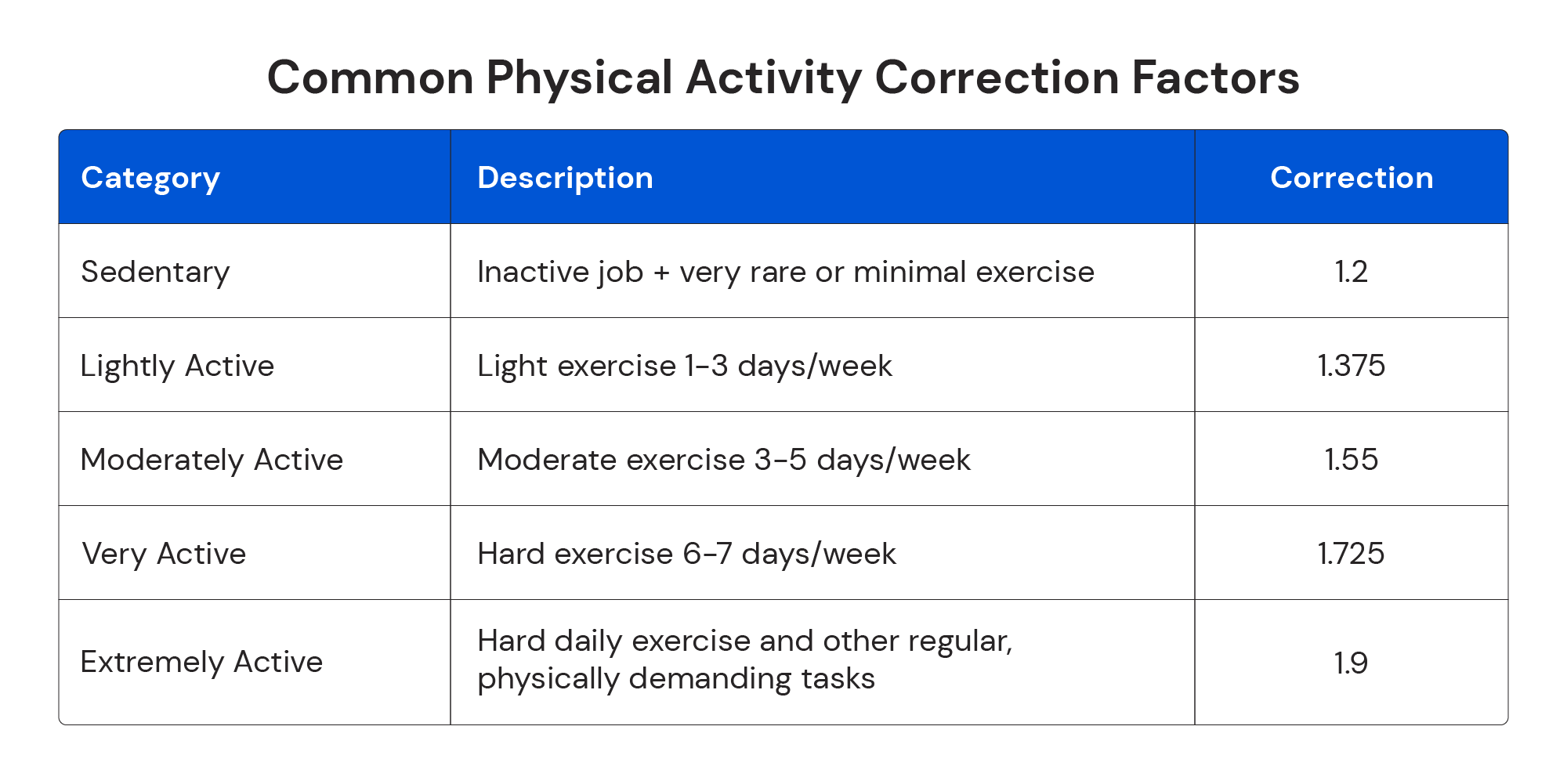
Right away, we can see one potential source of error: misclassifying your activity level. How do you know whether you’re sedentary or lightly active? Or moderately active versus very active? Most calculators and resources don’t provide a ton of guidance to help you select the appropriate activity multiplier, and most don’t distinguish between dedicated exercise and other forms of activity (i.e. having a physically demanding job, or walking/biking to get around).
Looking at these category descriptions, you see indicators of non-exercise physical activity (“regular physically demanding tasks” or “inactive job”), exercise difficulty (light, moderate, or hard, which appears to be a combined metric representing intensity and duration), and exercise frequency (in days per week). However, there’s no clear way to isolate these independent elements and sum them to obtain a cumulative value, and there are several combinations of these variables that aren’t explicitly represented in the table. For example, hard exercise is paired with an assumption of high frequency (6-7 days/week), and light exercise is paired with an assumption of low frequency (1-3 days per week). It’s also implied that someone with a generally sedentary lifestyle (outside of exercise) does minimal exercise, and that someone with a high degree of non-exercise physical activity also does a lot of structured exercise. In short, the common physical activity correction factors are extremely ambiguous and difficult to objectively classify.
So, even if an equation perfectly predicted your BMR, choosing the wrong activity multiplier would mean misestimating your total daily energy expenditure by 10-15%.
Furthermore, since activity multipliers are discrete “buckets,” simply falling in between two multipliers can generate error. For example, let’s assume your total daily energy expenditure is 1.62-times your basal metabolic rate. The “moderately active” multiplier is 1.55 (4.3% lower than would be ideal), and the “very active” multiplier is 1.725 (6.1% higher than would be ideal). So, even if an equation estimated your basal metabolic rate with an error of less than 10%, the addition of activity multipliers might still mean that your estimated total daily energy expenditure is misestimated by ~15%. For most people, total daily energy expenditure is somewhere between 1.1-2.2 times higher than basal metabolic rate – within this range, the average error generated by this “bucketing” of activity factors means that estimations of total daily energy expenditure will have errors that are 4.2% larger than equation-derived estimates of basal metabolic rate even if everyone chooses the correct activity multiplier.

So, using equations or online calculators to estimate your total daily energy expenditure clearly comes with some degree of error, but how large are the typical errors generated by this method?
As far as I’m aware, there isn’t any research that directly examines this question. However, we can model it easily enough.
First, we need to estimate the typical distribution of actual basal metabolic rates. The Mifflin-St Jeor study, which was used to create one of the most popular BMR equations, found that the BMR distribution of ~500 subjects had a mean of 1564 calories, with a standard deviation of 336 calories. That seems like a reasonable starting point. So, I first generated ~3000 “subjects” with basal metabolic rates following a normal distribution with these characteristics.
From there, we need to generate a realistic set of estimated basal metabolic rates. Since the typical error of BMR equations is ~200 calories per day, I added a random integer to the set of “true” basal metabolic rates, with a mean of 0 and a standard deviation of 250 calories. That produces a set of “estimates” with the same mean as the set of “true” basal metabolic rates, where the average “estimate” differs from its corresponding “true” value by an average of about 200 calories. You can see the distribution of “true” and “estimated” BMRs in the figure below.
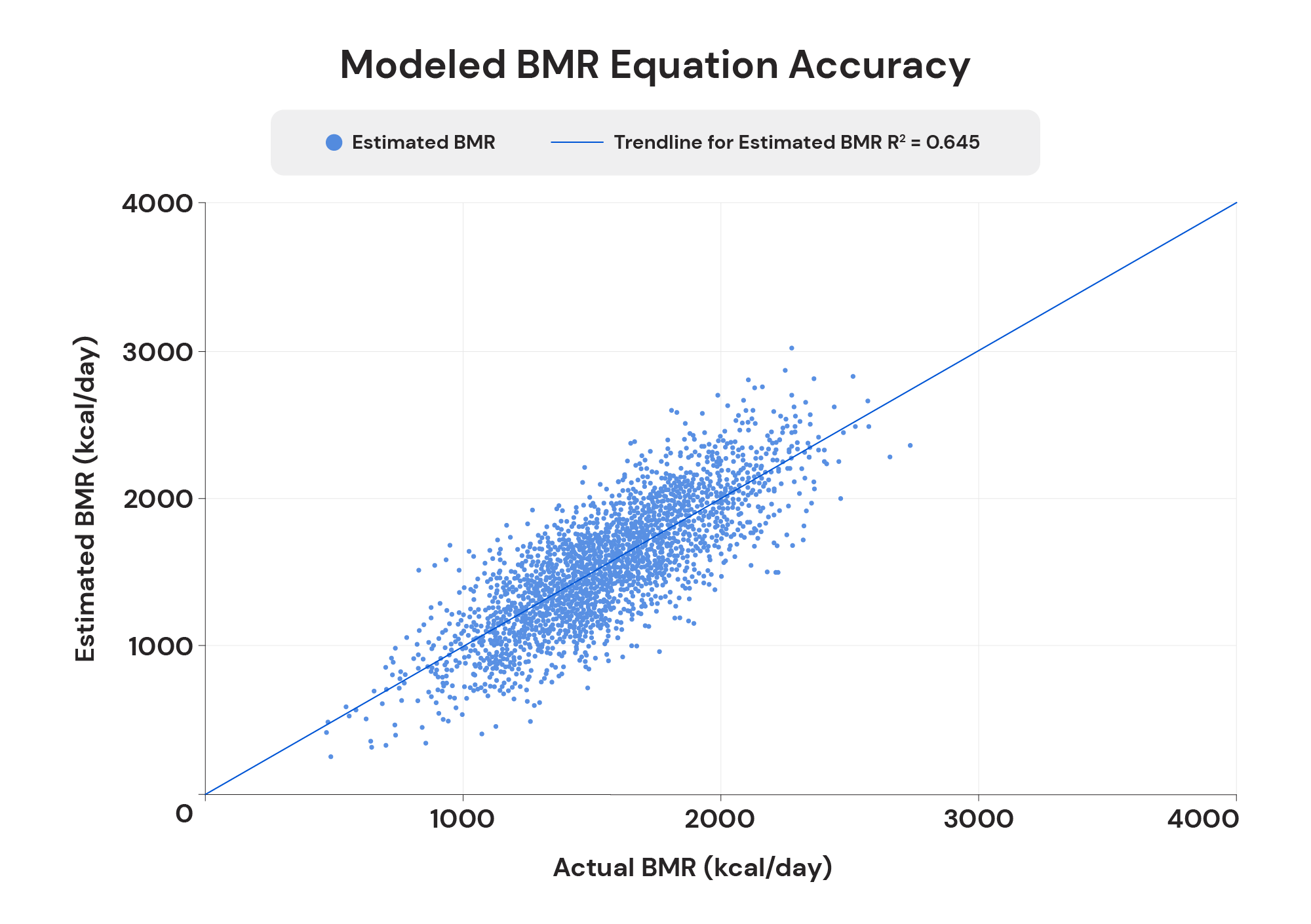
After that, we need to multiply these BMR values by activity factors to estimate total daily energy expenditures. For the “true” BMR values, I multiplied them by a normally distributed set of activity factors, with a mean of 1.55 and a standard deviation of 0.2 (meaning that the largest chunk of people are “moderately active,” with a pretty fair number of “very active” and “lightly active” folks, and a smaller number of “sedentary” and “extremely active” folks). For the “estimated” BMR values, I charitably assumed that all people would select the correct bucketed activity multiplier; for example, every person with a “true” activity multiplier closest to the “moderately active” multiplier of 1.55 would correctly rate themselves as moderately active, every person with a “true” activity multiplier closest to the “sedentary” multiplier of 1.2 would correctly rate themselves as sedentary, etc.
After this step, we have a set of “true” total daily energy expenditures, and a corresponding set of estimated total daily energy expenditures. You can see the distribution of “true” and “estimated” TDEEs in the figure below.
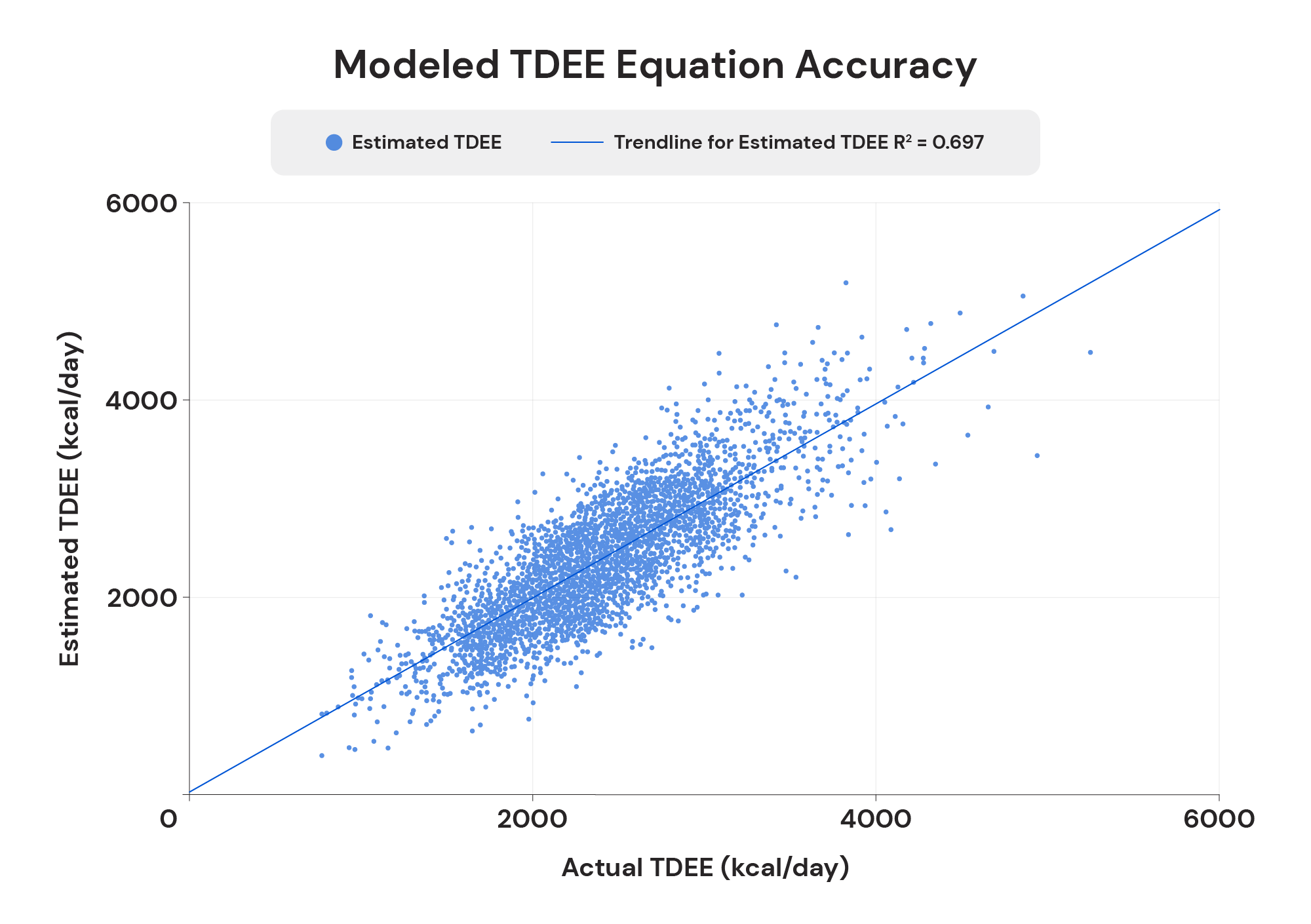

So, now we can answer the most pertinent question: what is the likelihood of this process generating TDEE estimates (and therefore calorie intake targets) that help you reach your goals?
The answer to this question is somewhat subjective. For example, if you want to lose a pound of fat per week, a general heuristic is that you’ll need an average daily deficit of approximately 500 calories (this isn’t a perfect estimate, but it’s a nice, round number that will work for illustrative purposes). If this whole process ends up recommending a level of energy intake that only results in a 100 calorie deficit (resulting in about 0.2lbs of fat loss per week), is that “close enough”? You’ll be moving in the right direction, but at a much slower rate than you want. Similarly, if this process results in a 1000 calorie deficit, you’ll certainly start off losing weight, but you may wind up with lower energy levels, more hunger, and more muscle loss than you wanted and expected. So, since different people will have different definitions of how close is “close enough,” I’ve displayed the results in the figures and table below.


As you can see, relatively few people (~20%) will get really accurate calorie recommendations from this process (errors smaller than 100 calories). Furthermore, a decent chunk of people (almost 30%) will get reasonably accurate calorie recommendations for their goals (errors between 100 and 250 calories). So, a little under 50% of people will get recommendations that meet my personal definition of “close enough.” In other words, if these folks wanted to lose a pound per week, this process would generate calorie targets consistent with losing somewhere between 0.5-1.5lbs per week for nearly 50% of individuals.
However, the largest group of people (a little over 30%) will have errors between 250-500kcal/day. For these folks, if they were aiming to lose 1lb per week, they’d wind up losing less than 0.5lbs per week, or between 1.5-2lbs per week. However, it’s worth noting that all of the people in this category would receive calorie recommendations that were at least directionally correct. They may lose weight at a glacial pace, or they may lose weight twice as fast as intended, but they’d at least be moving in the right direction (at least initially).
Moving on, about 20% of people will get recommendations with errors between 500-1000kcal/day. For these folks, aiming to lose 1lb per week will result in either weight gain, or rates of weight loss exceeding 2lbs per week. Finally, 1.5-2% of people will get errors exceeding 1000kcal/day, resulting in really, really bad recommendations.
So, using a TDEE estimation equation or calculator results in pretty solid calorie targets a bit less than half the time, and calorie targets that are at least within the right general ballpark (errors <500kcal/day) nearly 80% of the time. However, it also results in reasonably large errors (>250kcal/day) at least half of the time, and pretty inappropriate recommendations (errors >500kcal/day) more than 20% of the time. And keep in mind, when modeling this, I assumed that everyone would select the correct activity multiplier when converting their BMR estimate into a TDEE estimate. In the real world, some percentage of people will select the wrong activity multiplier, and thus receive even worse recommendations. (If you want to change the assumptions of the simulation described above, feel free to make a copy of this spreadsheet and tinker to your heart’s content.)
There’s one more major problem with this approach, however: there’s no built-in method of adjusting calorie targets as your exercise or physical activity habits change, or as you gain or lose weight.
Even simple changes in cardiovascular exercise habits or physical activity levels over time can introduce some complications, as some people tend to “compensate” for this activity-related energy expenditure via reductions in non-exercise energy expenditure, and the magnitude of this compensation varies considerably from person to person. As a result, it can be hard to confidently quantify the energy cost of a given change in cardiovascular exercise habits or physical activity levels, even if the change was intentional and carefully planned. A substantial increase in physical activity will surely increase TDEE, but it’s hard to make appropriate calorie target adjustments without knowing the magnitude of this increase. Of course, some changes in physical activity levels are entirely unintentional, and those are dramatically more difficult to quantify (if we even notice them).
When you get into a calorie deficit, your energy expenditure tends to decrease. Part of this decrease is the simple result of weight loss – you weigh less, so it takes less energy to keep your body running, to fuel movement, etc. However, you may also experience some decreases in basal metabolic rate, and you’ll likely experience decreases in NEAT. The opposite set of adaptations occurs when you get into a caloric surplus. Furthermore, these adaptations (collectively referred to as “metabolic adaptation”) differ between individuals: when two people lose the same amount of weight, one may not experience any decrease in total daily energy expenditure, and the other may experience a 500kcal/day reduction. So, even if a TDEE equation or calculator gives you appropriate calorie targets to start with, those calorie targets are unlikely to get the job done forever. One person may plateau after losing 5lbs, and another person may plateau after losing 20lbs, but everyone will likely need to make adjustments eventually.
Fortunately, making adjustments isn’t exactly rocket science, and there are plenty of heuristics people use for this purpose. For example, when your weight loss plateaus, you might reduce your calorie targets by 200-300kcal/day, or when your weight gain plateaus, you might increase your calorie targets by 100-200kcal/day.
However, there’s a significant potential drawback to this approach, which I’m going to refer to as “diet brain.”
Diet brain is the voice in the back of your head that overthinks and second-guesses everything:
“Has my weight actually plateaued, or am I just retaining water?”
“I decreased my calorie targets two weeks ago? Is it really time to reduce them again?”
“My weight is actually higher this week; do I need to slash my calorie targets by even more than normal?”
“I feel like I may be losing weight too fast; do I need to increase my calorie targets to avoid losing muscle? If so, how large should the increase be?”
“I’m going to start a new training program next week; I know my energy expenditure will change, but I don’t know how much I’ll need to adjust my calorie targets.”
In theory, it should be easy to take a step back, look at your data objectively, and make appropriate, dispassionate adjustments over time. In practice, some people find this process easy, and some people find it to be nearly impossible (myself included). This process may also require some additional effort, since it doesn’t just require that you record your weight and nutrition data – it also requires doing some amount of ongoing data analysis to decide when to adjust your calorie targets, and to decide how large those adjustments need to be. As a result, a lot of people hire nutrition coaches for $50-200/month, primarily for the purpose of having a second set of eyes to make dispassionate calorie adjustments to keep them on track toward their goals. However, this general process – starting with equation-derived BMR and TDEE estimates, and making ongoing adjustments to calorie targets based on your actual rate of weight gain or loss – is the best way to approach calorie counting.
The advantage of this approach over one-size-fits-all calorie targets should be obvious. One-size-fits-all targets are generally designed for crash dieting, leading to poor adherence, high burnout rates, and reduced odds of long-term success after you lose weight. One-size-fits-all targets are also generally used just for weight loss, meaning they’re not particularly useful for weight maintenance or intentional weight gain. However, one-size-fits-all targets also have some advantages over this process of using an equation-derived starting point, and making ongoing adjustments. For starters, if you have a goal of losing weight, really low, one-size-fits-all calorie targets will generally ensure that you start out in an energy deficit and initially lose weight pretty quickly, which might help with short-term motivation as you begin losing weight. A calorie calculator, on the other hand, might start you out in a very small energy deficit, or potentially even an energy surplus. While ongoing adjustments will sort things out over time, a rocky first month may drain some of your motivation. Second, one-size-fits-all calorie targets don’t require much additional thought – you’re aiming for (typically) 1200 calories per day, and that’s that. The process of manually making ongoing adjustments to your calorie targets will likely result in more physiologically appropriate calorie targets, but it might be easy to overthink things and second guess yourself, adding unnecessary stress to the process.
The advantage of this approach over calorie recommendations from wearable devices is also obvious: Both approaches have some degree of initial estimation error, but making calorie adjustments based on ongoing weight and nutrition data provides you with a way to correct any initial estimation error. As far as I’m aware, no such mechanism exists if a wearable device misestimates your daily energy expenditure.
In an ideal world, a single method of calorie counting would capture all of the upsides of this third approach to calorie counting (start with an initial, reasonably accurate estimate, and then make ongoing adjustments so you can gain or lose weight at the rate you want), while removing the two biggest drawbacks (the effort and requisite decision making required to make ongoing adjustments).
Method #4: MacroFactor
First off, you had to know that this would be the conclusion of this article. This is macrofactorapp.com, after all. However, I’d like to head off an objection you may have. I didn’t just write this article to frame MacroFactor in a positive light. Rather, we made MacroFactor because of the common problems and pitfalls we identified with the other popular approaches to calorie counting. However, if you have absolutely no interest in using MacroFactor, you can stop reading here, and treat everything you just read as an informative, standalone article.
MacroFactor’s algorithms and diet coaching functionality essentially automate the third approach to calorie counting discussed above. MacroFactor initially estimates your TDEE based on your lean body mass and activity levels, and then adjusts your calorie targets week-to-week to keep you on track as you pursue a goal of gaining, losing, or maintaining weight. All you need to do is track your nutrition and weight, and MacroFactor will handle the rest. You don’t need to do your own data analysis, and you don’t need to decide when to make calorie adjustments, thus mitigating a lot of the additional effort, overthinking, and second-guessing that often accompanies a self-guided attempt to gain, lose, or maintain weight with calorie counting.
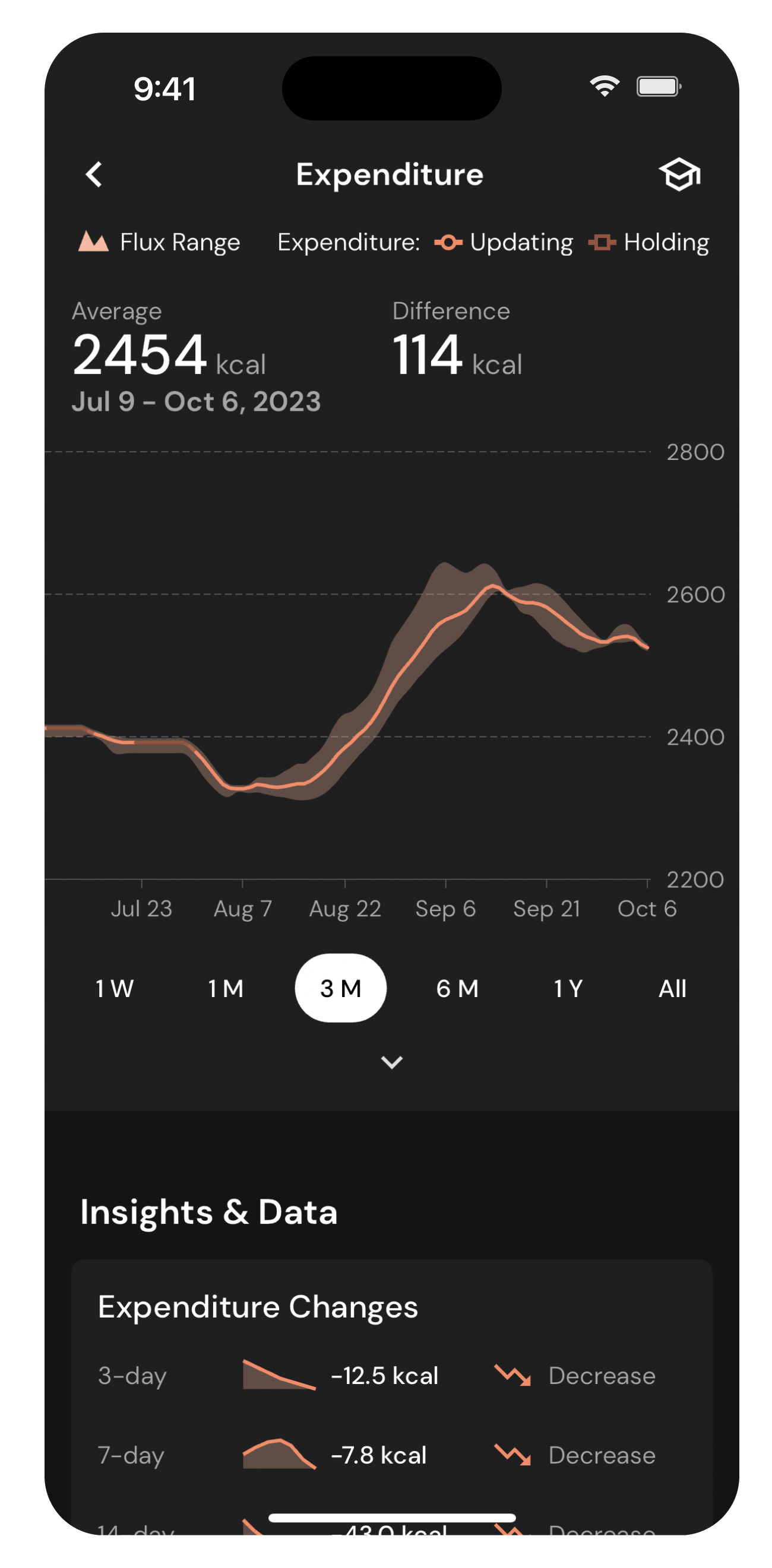
With MacroFactor, you can just focus on dietary, lifestyle, and habit modifications to help you reach your goals, instead of spending your mental resources worrying about whether your calorie targets are appropriate, or whether you’re gaining or losing weight too quickly or too slowly. Ultimately, those are the keys to long-term success. We’ll handle the math (that’s what machines are good at, after all) so you can focus on life.
MacroFactor helps you avoid the consequences of losing weight too fast (muscle loss, low energy, constant cravings, etc.) or too slowly (taking unnecessarily long to reach your goals), and the consequences of gaining weight too fast (gaining more fat than you’d prefer) or too slowly (spinning your wheels when trying to build muscle), thus providing you with a best-of-all-worlds approach to calorie counting for gaining, losing, or maintaining weight.





